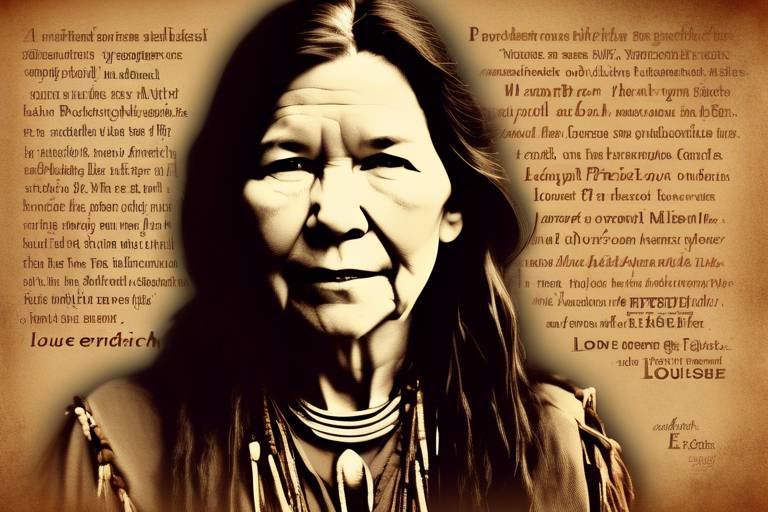Louise Erdrich - Native American Philosophies Portrayed in Literature
This article explores the rich tapestry of Native American philosophies as depicted in the works of Louise Erdrich, highlighting themes of identity, spirituality, and cultural resilience. Erdrich, a member of the Turtle Mountain Band of Chippewa Indians, intricately weaves her personal experiences and cultural heritage into her literature, creating a profound connection between her characters and the broader narratives of Native American life. Her storytelling not only captivates readers but also serves as a vital conduit for understanding the complexities of Native American philosophies.
Erdrich's writing is deeply rooted in Native American culture, showcasing traditions, beliefs, and the importance of storytelling in preserving heritage and fostering community connections. From the very first page, readers are immersed in a world where ancient customs intertwine with modern realities. Through her vivid descriptions and compelling narratives, she allows us to experience the beauty and struggles of Native American life. This cultural influence is not merely a backdrop; it is the very fabric of her stories, illustrating how cultural identity shapes individual experiences.
A central theme in Erdrich's work is the exploration of identity. Her characters often navigate the complexities of cultural identity, reflecting the struggles and triumphs of Native American individuals in contemporary society. For instance, in her novels, we see characters grappling with their dual identities—balancing their Native heritage with the demands of the modern world. This exploration raises poignant questions: What does it mean to belong? How do we reconcile our past with our present? Erdrich's characters are not just fictional creations; they are mirrors reflecting the realities faced by many Native Americans today.
Erdrich addresses the impact of historical trauma on Native American communities. Her narratives reveal how past injustices shape present identities, illustrating the resilience and strength of her characters. The scars of colonization, forced assimilation, and cultural erasure run deep, and Erdrich does not shy away from confronting these issues. Instead, she brings them to the forefront, allowing readers to grapple with the weight of history. Through her characters, we witness the struggle to heal and reclaim identity amidst the lingering effects of trauma.
Family dynamics play a crucial role in Erdrich's stories, highlighting the interconnectedness of relationships and the importance of familial ties in understanding one's identity and heritage. In many of her works, family is depicted not just as a unit but as a source of strength and resilience. Characters often find solace in their family histories, drawing on the wisdom of ancestors to navigate their own paths. This emphasis on family underscores a fundamental truth: our identities are shaped not only by our individual experiences but also by the legacy of those who came before us.
Erdrich emphasizes the significance of community in her narratives, showcasing how collective experiences and shared histories contribute to individual identities and cultural continuity. In her works, community is portrayed as a living entity, rich with stories, traditions, and a sense of belonging. Characters often find their identities intertwined with the fabric of their communities, illustrating that to understand oneself, one must also understand their place within the larger tapestry of life. This communal aspect of identity is a powerful reminder of the strength found in unity and shared experiences.
Nature and spirituality are intertwined in Erdrich's work, reflecting Native American beliefs that honor the earth. Her characters often find solace and guidance in the natural world, reinforcing their cultural connections. This deep reverence for nature is not merely poetic; it serves as a vital element in understanding Native American philosophies. The land is alive, filled with spirits and stories, and Erdrich's narratives invite readers to appreciate this profound relationship. Through her writing, we are reminded of the importance of respecting and protecting the environment as an extension of our own identities.
Erdrich's use of language is a powerful tool for storytelling. She blends English with Native languages, enriching her narratives and emphasizing the importance of linguistic heritage in cultural identity. This linguistic fusion not only enhances the authenticity of her characters but also serves as a reminder of the richness of Native American languages. By incorporating Native words and phrases, Erdrich honors her heritage while inviting readers to engage with the language and culture on a deeper level.
Incorporating myths and traditional stories, Erdrich creates a dialogue between past and present, allowing readers to appreciate the depth of Native American storytelling and its relevance in contemporary literature. These myths are not relics of the past; they are living narratives that continue to shape identities and inform perspectives. Through her storytelling, Erdrich bridges the gap between generations, reminding us that the wisdom of the past can guide us in navigating the complexities of modern life.
Erdrich's work addresses modern challenges faced by Native American communities, such as environmental concerns and social justice, bridging the gap between traditional philosophies and current realities. She does not shy away from tackling difficult subjects, instead using her platform to raise awareness and inspire change. By weaving contemporary issues into her narratives, she highlights the ongoing struggles faced by Native Americans, urging readers to reflect on their roles in fostering understanding and support.
- What themes are prevalent in Louise Erdrich's work? Erdrich often explores themes of identity, family, community, and spirituality, reflecting the complexities of Native American life.
- How does Erdrich incorporate Native American culture into her stories? She weaves cultural traditions, myths, and languages into her narratives, enriching her storytelling and emphasizing the importance of heritage.
- What role does family play in Erdrich's literature? Family dynamics are central to her stories, highlighting the interconnectedness of relationships and the influence of ancestral legacies on identity.
- How does Erdrich address contemporary issues in her writing? She tackles modern challenges such as environmental concerns and social justice, bridging traditional philosophies with current realities.

The Influence of Native American Culture
Louise Erdrich's writing is a vibrant tapestry woven from the rich threads of Native American culture. Her stories are not merely narratives; they are living embodiments of traditions, beliefs, and the profound significance of storytelling in preserving cultural heritage. Imagine a world where every tale told around a fire carries the weight of history and the warmth of community. This is the essence of Erdrich's work, where the past and present dance together, creating a rhythm that resonates with readers from all walks of life.
At the heart of her narratives lies a deep appreciation for the oral traditions that have been vital to Native American communities for generations. Storytelling, in Erdrich's view, is not just a form of entertainment; it is a means of transmitting knowledge, values, and identity. Through her characters, we witness how stories serve as bridges connecting the past to the present, allowing individuals to navigate their cultural landscape with a sense of belonging. The act of sharing stories fosters community bonds and reinforces the idea that one’s identity is intertwined with the collective experiences of their ancestors.
Erdrich’s portrayal of Native American culture also emphasizes the importance of spirituality and its connection to the natural world. For many Native American tribes, the earth is not merely a backdrop for human activity; it is a living entity deserving of respect and reverence. In her works, characters often draw strength and guidance from nature, reflecting the belief that the world around us is imbued with spiritual significance. This relationship with the land is a recurring theme in Erdrich's narratives, inviting readers to consider their own connections to the environment.
Moreover, Erdrich's writing highlights the resilience of Native American communities in the face of adversity. The cultural practices and beliefs that she depicts are not relics of the past; they are vibrant and evolving, adapting to contemporary realities while remaining rooted in tradition. This resilience is evident in the way her characters navigate the complexities of modern life, often finding strength in their cultural heritage. It serves as a reminder that while history may shape identities, it does not define them. Instead, it is the strength of community and the richness of cultural practices that empower individuals to forge their own paths.
In summary, Louise Erdrich’s work encapsulates the profound influence of Native American culture through her exploration of storytelling, spirituality, and resilience. By weaving these elements into her narratives, she not only honors her heritage but also invites readers to engage with the complexities of identity and belonging in a modern context. Through her lens, we come to understand that culture is not static; it is a living, breathing force that shapes our lives and connects us to one another.

Identity and Belonging
In the intricate world of Louise Erdrich's literature, the theme of identity emerges as a powerful force that shapes her characters' lives. The struggle for identity is not just a personal journey; it reflects the broader narrative of Native American communities grappling with their cultural heritage in a rapidly changing world. Erdrich's characters often find themselves at a crossroads, navigating the complex interplay between their Native roots and the modern society that surrounds them. This duality can create a sense of alienation and confusion, yet it also offers a profound opportunity for growth and understanding.
One of the most compelling aspects of Erdrich's exploration of identity is the way her characters confront their cultural heritage. They are often portrayed as individuals wrestling with the weight of their ancestors' histories while simultaneously seeking to carve out their own paths. This quest for belonging is not merely about personal fulfillment; it is deeply intertwined with the collective experience of their communities. Erdrich illustrates this through rich narratives that highlight the importance of family ties and community connections. In her stories, characters frequently turn to their families for guidance, love, and a sense of belonging, emphasizing that identity is not formed in isolation but is rather a tapestry woven from shared experiences.
Intergenerational trauma plays a significant role in shaping these identities. Erdrich deftly addresses how the historical injustices faced by Native American communities resonate through generations. The scars of the past influence the present, and her characters often grapple with the legacies of pain and resilience. This theme is poignantly illustrated in her narratives, where characters might reflect on their grandparents' struggles, drawing strength from their endurance while also feeling the weight of their unresolved traumas. The result is a rich exploration of how identity is both a personal and communal journey, marked by both struggles and triumphs.
Additionally, the notion of community is central to understanding identity in Erdrich's work. Her characters often find solace and strength in their communities, which serve as a bedrock for their identities. The shared histories and collective experiences of these communities create a sense of belonging that is vital for personal identity. In Erdrich’s narratives, the community is portrayed not just as a backdrop but as an active participant in the characters' journeys. The relationships formed within these communities are complex and multifaceted, often highlighting the interconnectedness of individuals' lives.
In conclusion, the exploration of identity and belonging in Louise Erdrich's literature reveals a profound understanding of the human experience. Her characters' journeys reflect a delicate balance between honoring their cultural heritage and forging their own identities in a contemporary context. Through rich storytelling and deep emotional resonance, Erdrich invites readers to engage with the complexities of identity, reminding us that while the journey may be fraught with challenges, it is also filled with moments of connection and understanding.

Intergenerational Trauma
In the intricate narratives crafted by Louise Erdrich, the theme of emerges as a poignant thread that weaves through the lives of her characters. This concept, which refers to the transmission of the effects of trauma from one generation to the next, is particularly significant within Native American communities. Erdrich's storytelling reveals how the scars of historical injustices—such as colonization, forced removal, and cultural assimilation—continue to shape the identities and experiences of contemporary Native Americans.
Through her characters, Erdrich invites readers to witness the profound impact of these past traumas on present-day lives. For instance, we see individuals grappling with feelings of dislocation and confusion as they navigate their cultural identities in a world that often marginalizes their heritage. The struggle is not just personal; it is deeply communal. The shared experiences of trauma create a collective memory that influences family dynamics and community relationships.
Erdrich's narratives often highlight the following aspects of intergenerational trauma:
- Emotional Burden: Characters frequently bear the weight of their ancestors' pain, which manifests in various emotional and psychological struggles.
- Resilience: Despite the heavy toll of trauma, Erdrich also showcases the strength and resilience of her characters, who find ways to heal and reclaim their identities.
- Connection to Heritage: The journey towards understanding and embracing one's cultural roots is a crucial aspect of overcoming intergenerational trauma.
Moreover, Erdrich's work serves as a mirror reflecting the broader societal issues faced by Native communities today. The trauma experienced by previous generations often leads to cycles of grief, addiction, and loss, which can be difficult to break. Yet, within this bleak landscape, there is also a sense of hope. Characters often engage in acts of remembrance and storytelling, which are vital for healing. By acknowledging their past, they forge a path toward a brighter future, one where their cultural identity can thrive.
In conclusion, the exploration of intergenerational trauma in Erdrich's literature is not just about recounting the past; it is about understanding how the past informs the present. Her characters embody the struggle for identity amidst the shadows of history, and through their journeys, readers gain insight into the resilience of Native American culture. By confronting these deep-seated issues, Erdrich not only illuminates the pain but also celebrates the enduring spirit of her people.
- What is intergenerational trauma?
Intergenerational trauma refers to the psychological effects of trauma that are passed down from one generation to another, often affecting the descendants of those who experienced the original trauma. - How does Louise Erdrich portray intergenerational trauma?
Erdrich portrays intergenerational trauma through her characters' struggles with identity and emotional burdens, reflecting the lasting impact of historical injustices on Native American communities. - What role does resilience play in Erdrich's narratives?
Resilience is a central theme in Erdrich's work, showcasing how characters navigate their trauma and seek healing through connection to their heritage and community.

The Role of Family
In Louise Erdrich's narratives, the role of family transcends mere biological connections; it embodies a profound sense of belonging and identity. Family dynamics are intricately woven into the fabric of her stories, illustrating how relationships shape the characters' lives and their understanding of self. For many of Erdrich's characters, family is not just a support system but a vital component of their cultural heritage. This interplay of personal and cultural identity is especially significant in Native American communities, where the notion of family extends beyond immediate relatives to embrace a broader network of kinship.
Erdrich often portrays family as a source of strength and resilience in the face of adversity. Characters grapple with the weight of their ancestors' experiences, revealing how intergenerational ties influence their present choices and identities. The stories delve into the complexities of familial relationships, showcasing moments of love, conflict, and reconciliation. Through these narratives, readers witness the powerful bonds that can either uplift or burden individuals, reflecting the intricate dance of loyalty and independence.
Moreover, Erdrich emphasizes the importance of storytelling within families, highlighting how oral traditions serve to connect generations. Elders pass down wisdom and cultural practices, ensuring that the younger members remain rooted in their heritage. This act of storytelling is not merely a way to share history; it is a means of forging identity and community. Erdrich’s characters often find solace in these narratives, as they navigate the challenges of modern life while holding onto the teachings of their ancestors.
To illustrate the multifaceted role of family in Erdrich's work, consider the following aspects:
- Support Systems: Families often provide emotional and practical support, helping individuals navigate life's challenges.
- Identity Formation: Family relationships play a crucial role in shaping one’s sense of self and cultural identity.
- Tradition and Continuity: The transmission of cultural values and traditions through family stories ensures the survival of cultural heritage.
In conclusion, the role of family in Louise Erdrich's literature is a testament to the enduring power of relationships. It highlights how familial ties not only influence individual identities but also serve as a bridge to cultural continuity. Through her rich characterizations and intricate storytelling, Erdrich invites readers to reflect on their own familial connections and the ways in which these relationships shape their understanding of the world.

Community and Belonging
In the intricate tapestry of Louise Erdrich's narratives, the themes of community and belonging are not just mere backdrops; they are the vibrant threads that weave her characters into the fabric of their cultural heritage. Erdrich illustrates that to belong is to be part of something larger than oneself—a collective identity that transcends individual experiences. This sense of community is often depicted as a sanctuary, a place where characters find solace and strength amidst the chaos of contemporary life. Through her storytelling, she portrays how the interconnectedness of relationships within a community fosters resilience and nurtures the spirit.
Erdrich's characters often grapple with the tension between personal aspirations and the expectations of their communities. For them, belonging is not merely about physical presence but involves a deep emotional and spiritual connection to their roots. The struggle to maintain this connection in a rapidly changing world is palpable. In her works, we see characters who are torn between the allure of modernity and the pull of their ancestral traditions. This duality reflects a broader narrative of Native American life, where the past and present collide, creating a rich dialogue that resonates with readers.
Moreover, the importance of community is often highlighted through communal rituals and gatherings. These events serve as a reminder of shared histories and collective memories, reinforcing the bonds that tie individuals to their cultural identity. For instance, in one of Erdrich's celebrated novels, the depiction of a traditional powwow not only showcases vibrant cultural expressions but also emphasizes the role of such gatherings in reinforcing community ties. Through music, dance, and storytelling, these events become a celebration of identity, allowing characters to reclaim their place within the larger narrative of their people.
In essence, Erdrich's portrayal of community is multifaceted. It encompasses the joys of togetherness, the challenges of navigating differing perspectives, and the profound impact of shared experiences. Her narratives invite readers to reflect on their own communities and the ways in which they contribute to a sense of belonging. As we journey through her stories, we are reminded that while individual paths may vary, the quest for connection and understanding remains a universal human experience.
Ultimately, the exploration of community and belonging in Erdrich's literature serves as a powerful reminder of the resilience of Native American cultures. It highlights the idea that, despite historical challenges and ongoing struggles, the bonds formed within communities provide a foundation for healing and growth. In a world that often feels fragmented, her work encourages us to seek out and nurture our connections, celebrating the diverse tapestries of identity that enrich our lives.
- What are the main themes in Louise Erdrich's work? Erdrich often explores themes of identity, community, spirituality, and resilience, particularly in the context of Native American experiences.
- How does Erdrich portray the concept of community? She depicts community as a vital source of strength and identity, emphasizing the interconnectedness of relationships and shared histories.
- What role does storytelling play in her narratives? Storytelling is central to Erdrich's work, serving as a means of preserving cultural heritage and fostering connections among characters.
- How does Erdrich address contemporary issues in her writing? She tackles modern challenges faced by Native American communities, weaving them into her narratives to bridge traditional philosophies with current realities.

Spirituality and Nature
In the vibrant tapestry of Louise Erdrich's literature, the themes of spirituality and nature are intricately woven together, reflecting the profound connection that Native Americans have with the earth. For many Indigenous cultures, nature is not merely a backdrop; it is a living entity that breathes, feels, and communicates. Erdrich captures this sacred relationship beautifully, portraying characters who find solace, guidance, and a sense of belonging in the natural world. It's as if the trees whisper secrets, the rivers carry ancestral wisdom, and the mountains stand as guardians of their stories.
Erdrich's characters often embark on journeys that are as much spiritual as they are physical. They seek not only to understand their place in the world but also to reconnect with the land that shapes their identities. This relationship is profoundly illustrated in her narratives, where the natural landscape becomes a character in its own right. The spirituality of her characters is deeply tied to the rhythms of nature, echoing the cyclical patterns of life that are celebrated in Native American philosophies.
Consider the way Erdrich describes the changing seasons. Each transition is not just a shift in weather but a reflection of life's journey—birth, growth, decay, and rebirth. This cyclical understanding of existence fosters a sense of respect and reverence for the environment. In her stories, the characters often engage in rituals that honor the earth, reinforcing the idea that spirituality is embedded in daily life. For instance, they might participate in ceremonies that celebrate the harvest or pay homage to the spirits of their ancestors, demonstrating how intertwined their lives are with the land.
Moreover, Erdrich often emphasizes the importance of listening to nature. Her characters are portrayed as keen observers, attuned to the subtle messages that the earth conveys. This idea resonates with the belief that the natural world is a teacher, offering lessons about resilience, adaptation, and the interconnectedness of all living things. In one memorable passage, a character might find clarity while walking through a forest, where the rustling leaves and chirping birds provide answers to their deepest questions. This connection to nature serves as a reminder that spirituality is not confined to the walls of a church or a specific belief system; it is found in the quiet moments spent outdoors, where one can truly feel alive.
In conclusion, the interplay of spirituality and nature in Erdrich's works invites readers to reflect on their own relationship with the earth. It challenges us to consider how we honor the land that sustains us and to recognize the wisdom that lies within the natural world. As we navigate our modern lives, perhaps we can take a page from Erdrich's book and strive to reconnect with the earth, finding peace and purpose in the beauty that surrounds us.
- What are the main themes in Louise Erdrich's work?
Erdrich's writing often explores themes of identity, spirituality, cultural resilience, and the interconnectedness of family and community. - How does nature influence the characters in Erdrich's stories?
The natural world serves as a source of guidance and solace for her characters, reflecting their spiritual beliefs and cultural heritage. - What role does storytelling play in Erdrich's literature?
Storytelling is a vital part of preserving Native American culture and identity, and Erdrich uses it to bridge the gap between past and present. - How does Erdrich address contemporary issues in her writing?
She tackles modern challenges such as environmental concerns and social justice, linking traditional philosophies with current realities.

Language and Storytelling
In the realm of literature, language is not merely a tool for communication; it is a living entity that breathes life into stories. Louise Erdrich masterfully demonstrates this in her works, where she intertwines English with Native languages, creating a rich tapestry that enhances her narratives. This blend not only captivates readers but also serves as a powerful reminder of the importance of linguistic heritage in shaping cultural identity. Through her writing, Erdrich invites us to consider how language can act as a bridge between generations, preserving traditions and fostering a sense of belonging.
One of the most striking aspects of Erdrich’s storytelling is her ability to convey profound themes through the nuances of language. She employs a variety of literary devices, such as metaphor and symbolism, to enrich her characters' experiences. For instance, the way she describes landscapes often reflects the emotional states of her characters, creating a deep connection between them and the natural world. This connection is not just about physical surroundings; it embodies a spiritual relationship that many Native American cultures hold dear. In this way, language becomes a vessel for expressing the complexities of identity and belonging.
Moreover, Erdrich's use of storytelling is deeply rooted in the oral traditions of Native American culture. Storytelling is not just a means of entertainment; it is a sacred practice that carries the weight of history and wisdom. By incorporating myths and traditional stories into her narratives, Erdrich creates a dialogue between the past and the present. This approach allows readers to appreciate the depth of Native American storytelling and its relevance in contemporary literature. It reminds us that stories have the power to heal, to teach, and to connect us to our roots.
To illustrate this, consider the following table that highlights key elements of Erdrich's storytelling style:
| Element | Description |
|---|---|
| Language | Erdrich blends English with Native languages, enriching her narratives. |
| Metaphor | Descriptive language that connects characters to their environment. |
| Oral Tradition | Incorporates myths and stories to convey cultural wisdom. |
Through her innovative use of language, Erdrich not only preserves the essence of Native American culture but also challenges readers to reflect on their own identities. Her narratives often provoke questions about the nature of belonging and the significance of one's roots. In a world that can sometimes feel fragmented, her stories serve as a reminder of the bonds that tie us to our heritage and to each other.
In conclusion, the art of storytelling in Louise Erdrich's work is a vibrant celebration of language and culture. It emphasizes that every word carries weight, every story has power, and every voice deserves to be heard. As we delve into her writings, we are reminded that language is not just a means of communication; it is a profound expression of who we are.
- What themes are prevalent in Louise Erdrich's work? Erdrich often explores themes of identity, spirituality, and cultural resilience through her characters and narratives.
- How does Erdrich incorporate Native languages into her writing? She blends English with Native languages, enriching her storytelling and emphasizing the importance of linguistic heritage.
- What role does storytelling play in Native American culture? Storytelling is a sacred practice that preserves history, teaches wisdom, and fosters community connections.
- How does Erdrich address contemporary issues in her work? She tackles modern challenges faced by Native American communities, bridging the gap between traditional philosophies and current realities.

Myth and Tradition
In the vibrant tapestry of Louise Erdrich's literature, are not merely embellishments; they are the very threads that weave together the fabric of her narratives. Erdrich adeptly incorporates Native American myths and stories, creating a rich dialogue between the past and the present. This interplay allows readers to experience the profound wisdom embedded in these traditions while simultaneously addressing contemporary issues faced by Native communities.
One of the most striking aspects of Erdrich's storytelling is her ability to blend traditional narratives with modern experiences. For instance, her characters often draw upon the teachings of their ancestors to navigate the complexities of contemporary life. This connection to the past serves as a compass, guiding them through challenges and affirming their cultural identity. It’s almost as if the myths act as a bridge, linking the struggles of today with the lessons learned from yesteryears.
Erdrich's use of myth is not just for storytelling; it also serves a critical purpose in preserving cultural heritage. By weaving traditional stories into her work, she ensures that these narratives remain alive and relevant. This is particularly important in a world where many indigenous stories risk being forgotten. The act of storytelling itself becomes a ceremonial practice, a way to honor the past while educating future generations. It’s like planting seeds in a garden; with care and attention, these seeds can grow into a rich landscape of knowledge and understanding.
Moreover, Erdrich’s characters often embody the struggles of reconciling their cultural heritage with the demands of modern society. They grapple with questions of identity, belonging, and the weight of ancestral expectations. This exploration is reminiscent of the hero's journey, where the protagonist must confront challenges to emerge transformed. Just as in traditional myths, Erdrich’s characters face trials that test their resilience and ultimately lead them to a deeper understanding of themselves and their place in the world.
The presence of myth in Erdrich's work also serves to challenge stereotypes and misconceptions about Native American culture. By presenting these stories with depth and nuance, she invites readers to engage with the complexities of Native life. It's a call to move beyond simplistic narratives and to appreciate the rich, multifaceted identities that exist within these communities. In doing so, Erdrich becomes a modern-day storyteller, using her pen to illuminate the shadows of history while celebrating the strength of her people.
In conclusion, the integration of myth and tradition in Louise Erdrich's literature is a powerful testament to the enduring relevance of Native American storytelling. It not only enriches her narratives but also fosters a deeper connection between the reader and the cultural wisdom of indigenous peoples. Through her work, Erdrich reminds us that these stories are not relics of the past; they are living entities that continue to shape identities and inspire resilience in the face of adversity.
- What themes are prevalent in Louise Erdrich's work?
Erdrich often explores themes of identity, spirituality, cultural resilience, and the impact of intergenerational trauma. - How does Erdrich incorporate Native American mythology in her stories?
She weaves traditional myths into her narratives, creating connections between past and present, and using them to address contemporary issues. - Why is storytelling important in Native American culture?
Storytelling preserves cultural heritage, imparts wisdom, and fosters community connections, making it a vital aspect of Native identity.

Contemporary Issues
In her compelling narratives, Louise Erdrich does not shy away from addressing the pressing contemporary issues that affect Native American communities today. Her works serve as a mirror reflecting the myriad challenges faced by these communities, ranging from environmental degradation to social justice. It’s as if she’s holding up a lens, allowing readers to see not just the beauty of Native culture, but also the struggles that persist in modern society.
One of the most significant contemporary issues highlighted in Erdrich's writing is the environmental crisis. Many Native American tribes find themselves at the forefront of battles against corporations and government entities that threaten their sacred lands and natural resources. For instance, the ongoing fight against oil pipelines that traverse tribal lands has become a rallying point for many indigenous activists. Erdrich's characters often embody this fight, illustrating the deep connection between their identity and the land. Nature is not merely a backdrop in her stories; it is a living entity that shapes and defines the characters’ lives.
Furthermore, Erdrich sheds light on the issue of social justice, particularly in relation to the legal and systemic inequalities that Native Americans face. From the struggles against poverty and unemployment to the fight for better education and healthcare, her narratives resonate with the realities of many indigenous people today. Through her characters, readers gain insight into the resilience required to navigate these obstacles. The stories serve as a reminder that the fight for justice is ongoing and that the voices of Native Americans must be amplified in the discourse surrounding these issues.
Erdrich also incorporates the theme of cultural survival, showcasing how Native communities are actively working to preserve their languages, traditions, and identities in the face of modern challenges. This cultural resilience is a testament to the strength of these communities, as they strive to keep their heritage alive while adapting to changing times. In her works, one can find a beautiful blend of tradition and modernity, where characters engage with contemporary issues while remaining deeply rooted in their cultural practices.
To illustrate the various contemporary issues highlighted in Erdrich's work, consider the following table that summarizes some of these challenges:
| Contemporary Issues | Description |
|---|---|
| Environmental Crisis | Threats to sacred lands and natural resources, including battles against oil pipelines. |
| Social Justice | Legal and systemic inequalities affecting education, healthcare, and employment. |
| Cultural Survival | Efforts to preserve languages and traditions amidst modern challenges. |
In conclusion, Louise Erdrich’s work serves not only as a celebration of Native American culture but also as a critical commentary on the contemporary issues that these communities face. Through her nuanced storytelling, she invites readers to engage with the realities of modern Native life, fostering a deeper understanding and appreciation for the ongoing struggles and triumphs of indigenous peoples. The themes she explores are relevant not just to Native Americans but to all who seek to understand the complexities of identity, culture, and resilience in the face of adversity.
- What are some key themes in Louise Erdrich's work? Erdrich often explores themes of identity, spirituality, cultural resilience, and contemporary social issues.
- How does Erdrich portray Native American culture in her writing? She integrates traditions, beliefs, and storytelling, emphasizing their importance in preserving heritage.
- What contemporary issues does Erdrich address? Issues such as environmental crises, social justice, and cultural survival are prevalent in her narratives.
- Why is storytelling important in Erdrich's work? Storytelling serves as a means of cultural transmission and a way to connect past and present experiences.
Frequently Asked Questions
- What themes does Louise Erdrich explore in her works?
Louise Erdrich's works delve into a variety of themes, including identity, spirituality, and cultural resilience. She often examines the complexities of Native American identity and the impact of intergenerational trauma on individuals and communities.
- How does Erdrich portray Native American culture?
Erdrich's writing is deeply rooted in Native American culture, showcasing traditions, beliefs, and the significance of storytelling. Her narratives preserve heritage and foster community connections, illustrating the rich tapestry of Native American life.
- What is the significance of family in Erdrich's stories?
Family dynamics are crucial in Erdrich's narratives. They highlight the interconnectedness of relationships and emphasize how familial ties contribute to understanding one's identity and heritage, reinforcing the importance of community.
- How does Erdrich address the concept of intergenerational trauma?
Erdrich poignantly addresses the impact of historical injustices on Native American communities. Her characters often reflect the struggles born from past traumas, showcasing their resilience and strength in navigating contemporary society.
- What role does nature play in Erdrich's writing?
Nature and spirituality are intricately connected in Erdrich's works. Her characters frequently find solace and guidance in the natural world, reflecting Native American beliefs that honor the earth and its significance in cultural identity.
- How does Erdrich incorporate language into her storytelling?
Erdrich masterfully blends English with Native languages, enriching her narratives and emphasizing the importance of linguistic heritage. This approach not only enhances the storytelling but also highlights the cultural identity of her characters.
- What contemporary issues does Erdrich address in her literature?
Erdrich's work often tackles modern challenges faced by Native American communities, such as environmental concerns and social justice. She bridges the gap between traditional philosophies and current realities, making her stories relevant today.



















